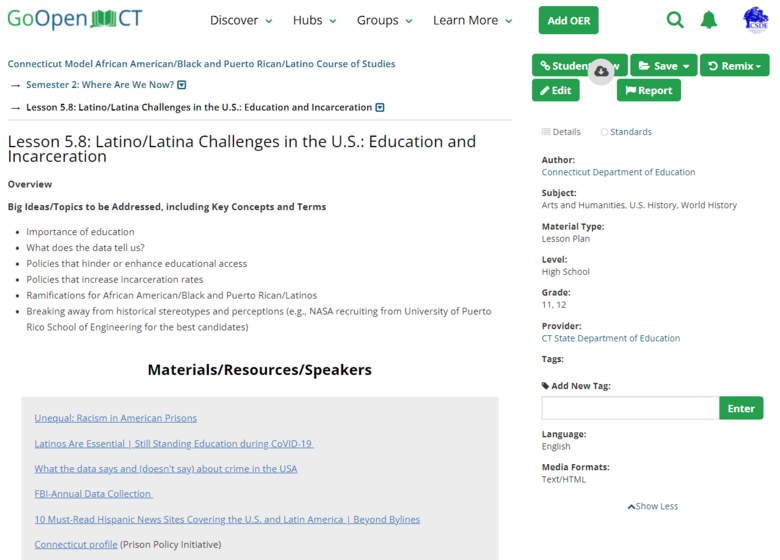Lesson 5.8: Latino/Latina Challenges in the U.S.: Education and Incarceration

Overview
Big Ideas/Topics to be Addressed, including Key Concepts and Terms
Importance of education
What does the data tell us?
Policies that hinder or enhance educational access
Policies that increase incarceration rates
Ramifications for African American/Black and Puerto Rican/Latinos
Breaking away from historical stereotypes and perceptions (e.g., NASA recruiting from University of Puerto Rico School of Engineering for the best candidates)
Materials/Resources/Speakers
Unequal: Racism in American Prisons
Latinos Are Essential | Still Standing Education during CoVID-19
What the data says and (doesn't say) about crime in the USA
10 Must-Read Hispanic News Sites Covering the U.S. and Latin America | Beyond Bylines
Connecticut profile (Prison Policy Initiative)
Hispanic Network Magazine | A Hispanic News Source -
https://hispanicexecutive.com/
Highest to Lowest - Prison Population Total
Colonial Lessons: The Politics of Education in Puerto Rico, 1898–1930 | The American Historian
Top 10 Spanish-Language Newspapers
Rios, V. (2011). Policing the Lives of Black and Latino Boys. New York: New York University Press.
Rios, V. (2011). Street Life, Poverty, Gangs and a Ph.D. New York: New York University Press.
Rios, V. (2017). Human Targets: Schools, Police, and the Criminalization of Latino Youth
Lebron, M. (2019). Policing Life and Death: Race, Violence, and Resistance in Puerto Rico. University of California Press.
Davenport, B. (2016). Grit and Hope: A Year with Five Latino Students and the Program That Helped Them Aim for College. University of California Press.
Nunez, E. (2014). Hanging out and Hanging On: From the Projects to the Campus. Rowman & Littlefield.
Recommended Learning Activities, including UDL Principles/Scaffolded Supports and Asynchronous and Synchronous Learning Opportunities
Day 1
Initiation: Provide national and state data regarding education and incarceration rates disaggregated by race and gender. (Education levels of recent Latino immigrants in the U.S. reach new highs, Today’s newly arrived immigrants are the best-educated ever, Real America With Jorge Ramos - Jorgeramos.com)
Activity: Students consider education and community policies that have contributed to stereotypes and oppression for African American/Black and Puerto Rican/Latino youth and reflect on Horace Mann quote, “Education is the great equalizer.”
Day 2
Activity: Students analyze how the media cover African American/Black and Puerto Rican/Latino youth/people who have been incarcerated. Students compare mainstream and Black/Hispanic/Latino-specific news articles or media news clips for stories, paying special attention to the contrast of the Black/Latino perspective. Examples:
'LatiNation' speaks to the importance of Latinos in U.S. society
Chicano/Latino Newspapers - Newspapers - Research Guides at University of Southern California https://www.wnycstudios.org/podcasts/la-brega, PreviousTop 45 Latino Podcasts To Follow in 2021
Closing: Students identify major learnings to share with school community (e.g., Student Council, Board of Education, Town Council, State Board of Education, CT Black and Hispanic Caucus, etc.).
Home Links/Reflections to Affirm Identity
Students have a discussion with their families using the following prompt: What can be done locally and nationally to make sure Latino voices are represented in important conversations about key legislation?
Options for Content Continuity Across History Courses and Interdisciplinary Integration
English
Humanities
Political Science
Extensions/Experiential Opportunities
Students have a class discussion on the effects of discrimination for Latinos. Consider: Many Hispanics worried about their place in U.S., faced discrimination before COVID-19